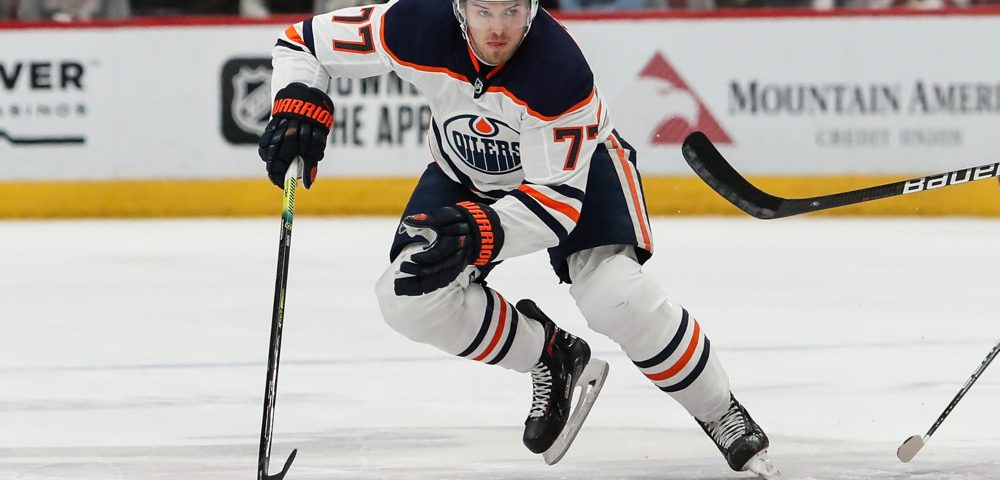
It’s Time to Trade Barrie
July 5, 2022
Oilers bringing back classic royal blue jersey
July 8, 2022Moving Klefbom’s Contract Would Provide More Cap Savings Than Putting Him on LTIR

GLENDALE, AZ - FEBRUARY 04: Edmonton Oilers defenseman Oscar Klefbom (77) skates with the puck during the NHL hockey game between the Edmonton Oilers and the Arizona Coyotes on February 4, 2020 at Gila River Arena in Glendale, Arizona. (Photo by Kevin Abele/Icon Sportswire)
Ken Holland told the assembled media that he expects to be operating in long-term injury relief (LTIR) next season during his end of season availability. Mike Smith could be a reason for that because Holland said that he’s “banged up pretty bad” during Wednesday’s pre-draft media availability, but we already know that Oscar Klefbom won’t play hockey once again next season.
LTIR allows a team to get some salary cap relief when a player is going to miss more than ten games and 24 days with an injury. The injured player’s cap hit always counts towards the cap. However, a team can increase their cap spending by the amount of the injured player’s cap hit after he is placed on LTIR.
Note what that does not mean. That does not mean that the team gets to surpass the salary cap by the amount of the injured player’s cap hit.
Hypothetically, let’s say that a team’s cap spending is at $82 million. An injured player with a cap hit of $1.5 million gets placed on LTIR. That means that the team could then increase their cap spending to $83.5 million. That is only $1 million over the expected salary cap for the 2022-23 season ($82.5 million).
That means that the Oilers won’t benefit from putting Klefbom on LTIR unless their cap spending is within the value of Klefbom’s contract of the cap. It also means that there is no way to get relief matching the FULL value of Klefbom’s contract. The way to get the maximum benefit of putting Klefbom on LTIR is to spend as close to the cap as possible.
Spending as close to the cap as possible maximizes the benefit of LTIR, but it limits a team’s ability to add players throughout the season, especially at the trade deadline. Colorado was able to add Josh Manson and Arturri Lehkonen at the trade deadline last season because they had some cap space. The Oilers were only able to add Brett Kulak and Derrick Brassard. Brassard only cost them approximately $400k in cap space, which is the only reason that they were able to make that trade.
If you were wondering why the incompetent general manager refused to make a big deadline acquisition during a season where the team’s two superstars were in their primes, the fact that they were in LTIR because of an unfortunate injury to a great young player and person had a lot to do with it.
Look at this Tweet from CapFriendly (@CapFriendly)after the recent Shea Weber trade:
“Why’d MTL make this trade? No club wants to use LTIR. It’s restrictive to roster construction (no pro-rating so recalls cost more cap space), and makes an overage penalty significantly more likely This trade enables the possibility of the #Habs operating without LTI this season”
A team can’t use up all of that LTIR relief because they need space to be able to recall players in case of other injuries throughout the course of the season. Placing a player on the injured reserve doesn’t remove that player’s cap hit, so a recall just adds more cap spending. A recalled player counts for a higher value against the cap than they normally would if the team is operating in LTIR. They need to have space to account for recalls throughout the season.
The only way for the Oilers to get full relief from Klefbom’s contract is to trade it away.
There’s only one year left in Klefbom’s contract. The Oilers could just suck it up and wait it out, but they are in a bit of a cap bind this summer. As of right now, they have three important restricted free agents that need contracts. They have the Evander Kane situation on their hands. They would like to re-sign Kulak. They would also like to upgrade their situation in goal.
Trading the Klefbom contract would open up $4.167 million without taking anything away from the current roster. There is merit in trading Zack Kassian or Tyson Barrie for the cap savings, but the Oilers stand to gain the most cap space from trading Klefbom’s contract (unless Barrie can be moved without taking a contract back).
Trading Klefbom’s contract away would come with a price though.
Dallas recently traded Ben Bishop’s contract to Buffalo for “future considerations”, which ended up being a seventh round pick. Bishop has a cap hit of $4,916,667 for the coming season. Klefbom’s contract is only $4,167,000, so the price to move it doesn’t necessarily have to be high.
However, the Maple Leafs traded the last year of Patrick Marleau’s contract along with a first round pick and a seventh round pick to Carolina for a sixth round pick in 2019. Marleau’s cap hit was $6.25 million at the time of the trade. Carolina also bought him out, which added a cap hit for the next two seasons after that rather than just the one. Those factors brought the return up for Carolina.
Arizona did a couple of similar deals last summer. They acquired Andrew Ladd ($4,375,000), two second round picks, and a conditional third round pick for NOTHING. They also acquired Shayne Gostisbehere ($4,500,000), a second round pick, and a seventh round pick for “future considerations”. Both Ladd and Gostisbehere played for the Coyotes last season. Their cap hits were similar to Klefbom’s ($4,167,000), but Klefbom won’t play. That might drive the cost of moving his contract up.
The Oilers have their 2022 first, fifth, sixth, and seventh round picks. Including a seventh round pick would be a no brainer, but the question is how high of a pick would Holland be willing to move in order to move Klefbom’s contract this summer.
The Oilers’ first round pick will fall late in the first round this year. The odds of a player picked in that spot being an impactful NHL player are about the same as those of a second rounder. I would move this year’s first round pick in a heartbeat. It would mean that the Oilers wouldn’t have a pick until round five, but they could recover a pick or two by trading Tyson Barrie, Zack Kassian, or Jesse Puljujarvi. Not having a pick until that late would bother me in a rebuilding year, but the Oilers are in win now mode. Having one year where they don’t get many new prospects in the pipeline will be alright if it can help the team win now.
If it’s not this year’s first round pick, then Holland could potentially include the 2023 second round pick in a Klefbom trade. They could also trade back in this year’s draft for multiple picks and use one of those to move Klefbom’s contract. Where there’s a will, there’s a way.
Getting LTIR relief for Klefbom sounds like a solid game plan in theory, but it is not the best case scenario for the Oilers in 2022-23.

